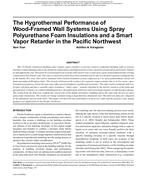Description
The US Pacific Northwest building codes require vapor retarders or barriers used in residential building walls to prevent moisture-related damages due to the moderate temperatures and high moisture levels caused by precipitation and relative humidity throughout the year. Research on wood-framed wall systems with exterior stucco and cavity spray polyurethane foams is being conducted in this climate zone. Two stucco-clad wall systems have been installed side by side in a natural-exposure testing facility in the Seattle, WA, area. One wall is insulated with a hybrid insulation system comprised of 2 in. spray polyurethane closed-cell foam and unfaced fiberglass batts. The closed-cell foam works in place of a separate vapor retarder due to its low water vapor transmission property, and at the same time offers good airtightness and thermal resistance. The other wall is insulated with 6 in. of open cell foam and has a variable-vapor-resistance “smart vapor” retarder attached to the interior surfaces of the foam and gypsum layer. Contrary to common building practice, the application of interior wall cavity foam requires careful moisture design. The results from the field tests confirm the critical role of the highly absorptive cladding and at the same time the use of cavity spray foam insulations. The results are being extended using a hygrothermal simulation tool. The field test data are compared to the simulation tool for both walls. This paper will describe the performance of these two walls and the need for clear design guidance for application in the Pacific Northwest.
Citation: Thermal Performance, International Conference, 2010
Product Details
- Published:
- 2010
- Number of Pages:
- 9
- File Size:
- 1 file , 3.4 MB
- Product Code(s):
- D-BUILDINGSXI-129




